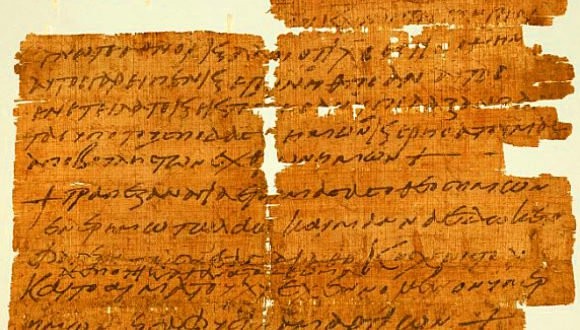‘Last Supper’ Papyrus Provides Glimpse Into Early Christian Magic Practices
| Kristina Fernandez | | Sep 07, 2014 02:45 AM EDT |
(Photo : University of Manchester via manchester.ac.uk ) The 1,500 year old Greek papyrus believed to be the earliest surviving evidence of magic practice among Christians.
In an accidental finding, an ancient Greek papyrus believed to contain the earliest reference to magic as used in the Christian context was spotted among the thousand papyri kept in a library vault at the University of Manchester.
'This is an important and unexpected discovery as it's one of the first recorded documents to use magic in the Christian context and the first charm ever found to refer to the Eucharist - the Last Supper - as the manna of the Old Testament,' said Dr. Roberta Mazza, a research fellow at the John Rylands Research Institute.
Like Us on Facebook
The 1,500 year old papyrus fragment is believed to be the earliest surviving Christian amulet.
Dr. Mazza explained that the papyrus fragment was likely folded up and worn around the neck as a protective charm. The fragment is likely to have originated from Egypt where the ancient practice of using sacred texts to ward off danger was practiced.
Written on the papyrus were biblical texts from the Psalms and the Gospel of Matthew.
"Our God prepared a sacred table in the desert for the people and gave manna of the new covenant to eat, the Lord's immortal body and the blood of Christ poured for us in remission of sins," is one of the many texts identified on the remarkable document.
Dr. Mazza told Live Science that people at the time, believed that sacred texts had magical powers.
The amulet was written at the back of what seems to be a receipt for the payment of grain tax. The text on the front, refers to a certain tax collector from the countryside of Hermoupolis, an ancient Egyptian city.
Analysis of the document reveals that although the creator of the amulet had some knowledge of the Bible, he or she committed plenty of mistakes.
"This," according to the researchers, "suggests that he was writing by heart rather than copying it."
The amulet reportedly contains misspelled words and texts written in the wrong order.
Still, the papyrus fragment, according to Mazza, reveals that the ancient Christians adopted the ancient Egyptian practice of wearing sacred texts as amulets, a practice not different from the protective wearing of the cross or the images of saints, Christians do nowadays.
"To this day, Christians use passages from the Bible as protective charms so our amulet marks the start of an important trend in Christianity," said in a statement.
Dr. Mazza presented the findings at the international papyri conference held at the John Rylands Research Institute on September 4.
Tagslast supper papyrus, christian magic practices, amulet papyrus, University of Manchester, Roberta Mazza, Christian amulet, Greek papyrus
©2015 Chinatopix All rights reserved. Do not reproduce without permission
EDITOR'S PICKS
-

Did the Trump administration just announce plans for a trade war with ‘hostile’ China and Russia?
-

US Senate passes Taiwan travel bill slammed by China
-

As Yan Sihong’s family grieves, here are other Chinese students who went missing abroad. Some have never been found
-

Beijing blasts Western critics who ‘smear China’ with the term sharp power
-

China Envoy Seeks to Defuse Tensions With U.S. as a Trade War Brews
-

Singapore's Deputy PM Provides Bitcoin Vote of Confidence Amid China's Blanket Bans
-

China warns investors over risks in overseas virtual currency trading
-

Chinese government most trustworthy: survey
-

Kashima Antlers On Course For Back-To-Back Titles
MOST POPULAR
LATEST NEWS
Zhou Yongkang: China's Former Security Chief Sentenced to Life in Prison

China's former Chief of the Ministry of Public Security, Zhou Yongkang, has been given a life sentence after he was found guilty of abusing his office, bribery and deliberately ... Full Article
TRENDING STORY

China Pork Prices Expected to Stabilize As The Supplies Recover

Elephone P9000 Smartphone is now on Sale on Amazon India

There's a Big Chance Cliffhangers Won't Still Be Resolved When Grey's Anatomy Season 13 Returns

Supreme Court Ruled on Samsung vs Apple Dispute for Patent Infringement

Microsoft Surface Pro 5 Rumors and Release Date: What is the Latest?










